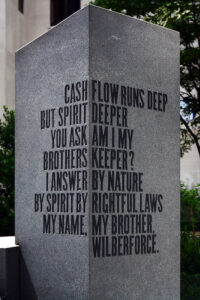
The sculpture Gilt of Cain, which stands in Fen Court, London, is by artist Michael Visocchi and poet Lemn Sissay. It commemorates the bicentenary of the abolition of the transatlantic slave trade in 1807, and was unveiled by Archbishop Emeritus Desmond Mpilo Tutu in 2008. Credit: diamond geezer. Attribution-NonCommerical-NoDerivs 2.0 Generic (CC BY-NC-ND 2.0). https://www.flickr.com/photos/dgeezer/51170948124/.
The Slave Compensation Act 1837: There have been many calls for the British government to compensate all African & Caribbean descendants. So, if one hears about a “slave compensation” it might be assumed that this has gone to the freed slaves to redress the injustices they suffered. Only that the money was paid to owners of slaves, who were being compensated for the loss of what had, until then, been considered their property.
The Act was not aimed at a more equal society, rather it was meant to further benefit the slave owners who were already enriched through buying and selling slaves. Slave owners were paid approximately £20 million in compensation in over 40,000 awards for freed enslaved people. Payments of the bonds to the descendants of creditors were finalised in 2015.

The sculpture Gilt of Cain, which stands in Fen Court, London, is by artist Michael Visocchi and poet Lemn Sissay. It commemorates the bicentenary of the abolition of the transatlantic slave trade in 1807, and was unveiled by Archbishop Emeritus Desmond Mpilo Tutu in 2008.
Credit: George Rex. CC Attribution Share Alike Generic (CC BY-SA 2.0). https://www.flickr.com/photos/rogersg/14266377756/